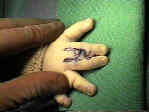
- Discussion:
- Weber C ankle fractures occur above the the syndesmosis and are similar to PER injuries in the
Lauge Hansen classification:
- classification:
- C: fibula fracture above syndesmosis
- C1 diaphyseal fracture of the fibula, simple
- C2 diaphyseal fracture of the fibula, complex
- C3 proximal fracture of the fibula
- frx above the syndesmotic result from external rotation or abduction forces that also disrupt
the syndesmosis and are usually associated with an injury to medial side;
- outcomes:
- in the report by Kennedy JG, et al, the authors noted that patients with low Weber C fractures, there was a clear
association between the severity of the fracture dislocation and a poor outcome;
- talar shift of greater than 1/2 the tibial articular surface is associated with significant articular and soft tissue comprimise;
- Evaluation of the syndesmotic screw in low Weber C ankle fractures.
- Radiographic Studies
- Operative Technique:
- postion:
- supine, tourniquet, hip bump, hip seat belt to allow table tilting
- a padded Mayo stand is helpful to help position the thigh in moderate abduction and the knee in flexion (which places
the leg in a lateral position);
- flouro on opposite side of table;
- lateral malleolar frx:
- surgical approach for lateral malleolar fracture:
- if a syndesmotic injury is present, be sure to place the incision more posteriorly, in order to facilitate insertion of the
syndesmotic screw;
- implant: 1/3 tubular plate and 3.5 mm cortical screws:
- comminuted frx:
- its essential that the fibula not be plated in a shortened position;
- take an x-ray of opposite ankle inorder to judge exact length of fibula;
- talocrural angle can be used to asses shortening;
- plate position:
- transverse frx: are reduced & fixed w/ 1/3 tubular plate;
- screws can be eccentrically positioned on each side of frx so that compression occurs when these screws are tightened;
- oblique frx: can be fixed w/ lag screw followed by neutralization plate;
- medial malleolus fractures:
- 4.0 mm cancellous bone screws, or 4.5 mm cannulated bone screws for the medial malleolar fracture;
- syndesmotic injury:
- anatomic reduction of both the fibular and the medial malleolus frx will usually restore the stability of the mortise;
- if there is evidence of deltoid ligament disuption but no frx, then syndesmotic fixation is usually required;
- in the report by Kennedy JG, et al, the authors examined the effect of syndesmotic screws in low Weber C fractures;
- low Weber C fractures are defined as being within 5 cm of the joint;
- 26 patients had ankle ORIF with syndesmotic fixation and 19 had ORIF w/o a syndesmotic screw;
- there was no significant difference between either group using subjective and objective criteria;
- Evaluation of the syndesmotic screw in low Weber C ankle fractures.

Ankle mortise stability in Weber C fractures: Indications for syndesmotic fixation.
The effect of fibular malreduction on contact pressures in an ankle fracture malunion model.
The influence of a diastasis screw on the outcome of Weber type-C ankle fractures.
Ankle fractures involving the fibula proximal to the distal tibiofibular syndesmosis.
Related Products
Roll-A-Bout
An alternative to crutches and wheelchairs. The Roll-A-Bout fully supports the lower leg guaranteeing 100% non-weight-bearing.

